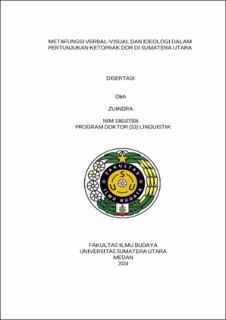Metafungsi Verbal-Visual dan Ideologi dalam Pertunjukan Ketoprak Dor di Sumatera Utara
Verbal-Visual Metafunction and Ideology in Ketoprak Dor Performances in North Sumatra

Date
2024Author
Zuindra, Zuindra
Advisor(s)
Setia, Eddy
Sinar, T Silvana
Nurlela
Metadata
Show full item recordAbstract
This study discusses the verbal and visual metafunctions in the Ketoprak Dor performance. In addition to verbal language, this study also examines visual language through images taken from performances as data analysis. This study applies the theory of Systemic Functional Linguistics (LFS) introduced by Halliday to analyse verbal metafunctions in the form of clauses in each utterance. Furthermore, to analyse visual metafunction, a multimodal approach introduced by Kress and Van Leeuwen is used. In addition to analysing the clauses and images contained in the show, the researcher also uncovers ideological representations contained in verbal and visual language based on social concepts, images and values according to the opinion of Hodge, Trew and Martin. This study used a qualitative descriptive approach which stated that research using descriptive techniques in the realm of language is research that does not change data in its analysis, but is carried out by describing and describing the data by the researchers themselves. From the overall results of the analysis of clauses and images in this study, the findings obtained include the metafunction of verbal language consisting of: 1) Ideational components (process, participants, goals and vocative). 2) Interpersonal components (mood, residue, subject, finite, predicator, adjunct and circumstance). 3) Textual components (themes; marked and unmarked tehmes, and rhemes). In the visual language metafunction, the constituent elements are: 1) Representational components (process, participant, goal, vocative and setting). 2) The interaction component (offer, impersonal, demand and colour saturation. 2) The compositional component (polarized, centered, and maximum salience, and maximum connection). The next findings are ideological representations contained in verbal and visual metafunctions, namely: 1) Social Concepts (pandem bromo, wearing scarves, using types of clothing, manners/etiquette). 2) Image (gender, material and social class). 3) Values (patience, trust, hope and courage). Based on the results of this study it was concluded that the clause structure in Ngoko Javanese with the Deli dialect can provide an understanding to the reader about the forming elements in the language clause. Besides that, by providing the elemental terms of the multimodal approach in visual metafunction, it gives readers an understanding of the interpretation of the meaning contained in each image in the Ketoprak Dor performance. Furthermore, there are forms of ideology that are represented in verbal and visual metafunctions which show that ideology is always present in every element of language, both verbal and visual.
